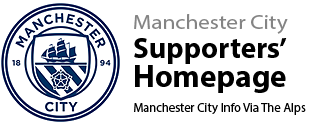The Maine Road Stadium
Maine Road was the home of Manchester City between 1923 and 2003. It was one of the largest football fields in Britain, and holds the record for the largest crowd at a match outside the national venues. The stadium was unofficially rated as one of the most atmospheric stadiums in world football in 2008 by the Daily Mail who commented that “Maine Road will always be one of English football’s legendary grounds”.
City played the last game at their Hyde Road home on 18 August 1923 and left straight after, taking with them just a few turnstiles and the goalposts. Their new site at Maine Road was two miles west of Hyde Road and about three miles east of Old Trafford.There seemed to be two advantages. Firstly, Moss Side was a densely populated suburb close to a vast new council housing development, with easy access from all South Manchester and the city centre, but secondly and most importantly, the site offered the chance to build the biggest stadium in England apart from Wembley, which had just been completed.
Construction
An architect named Charles Swain designed the new stadium, and the first job was to drain and level the site, until then used as a claypit for brick making. A sixteen and a quarter acre was purchased for £5,500. Maine Road was originally known as Dog Kennel Lane but renamed Maine Road (after the Maine law) during the 1870’s at the insistence of the Temperance Movement who owned land on Dog Kennel Lane and the local authority accepted their request. During construction, the stadium was reputedly cursed by a gypsy when officials evicted a gypsy camp from the area. This curse was allegedly removed on 28 December 1998. However, the gypsy curse is likely to be an urban myth, as such stories are endemic to a number of football league grounds. Construction took 300 days, the total cost £100,000. The initial layout of the ground consisted of one covered stand with a seating capacity of 10,000, and uncovered terracing on the other three sides, with gentle curves connecting the corners.
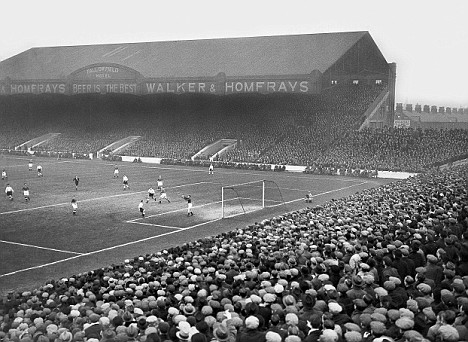
One stand was built, seating 10,000 on a single tier even though it did not run the complete length of the touchline. The rest of the ground was open terracing, a total of 20 miles of concrete steps. Estimates of the capacity ranged from 80 to 100,000 and the total cost of building came to nearly 200,000 pounds, a vast sum in those days. Lord Mayor W.Cundiff pronounced Maine Road open on 25 August 1923 when a crowd of 60,000 witnessed City’s opening first division fixture v. Sheffield United. The ground soon proved its capabilities. A crowd of 76,000 saw City v. Cardiff in the FA Cup quarter final later that season. In the 6th round, on 3 March 1934, the attendance v Stoke City of 84,569 was the highest of any English club match apart from a Cup Final.
Sharing with United
Just before the war, the Main Stand roof was carried round the corner and extended over the Platt Lane End. After the war, Maine Road became the busiest ground in the country for Old Trafford was unusable due to bomb damage and City played host to their neighbours. Both City and United were in top form and this, allied to the spectacular rise in attendances following the war, meant that Maine Road was packed to capacity.
The attendance of 80,407 for a Cup semi-final replay between Derby and Birmingham in 1946 was the highest ever recorded for a mid-week game, at a time when these were played in the afternoon.The following season, City won the Second Division Championship, United were runners up in the First Division and altogether some 2,850,000 spectators had attended Maine Road, a record for any League ground. In 1948, United attracted 82,950 for a match v. Arsenal, the highest ever League attendance, and 81,000 for their fifth round Cup tie v. non-league Yeovil.
Maine Road therefore held both the League and Cup attendance records. However though City were charging United up to 5000 pounds a season plus a share of the gate receipts, in 1949 they asked United to leave. Old Trafford was restored for the ’49-’50 season and City now had the ground to themselves. It did them no good, however, for in ’50 they were relegated. Typical City.:)
Those post-war years brought in large profits,and part of these were spent on what was then an unusual development – the installation of seats on the Platt Lane terracing.It took Maine Road’s seating capacity to 18,500, the highest in Britain.
Post WWII and floodlights
City were once more back in Division One, and on 14 October they switched on their floodlights for a friendly v. Hearts.This innovation brought United back for a series of mid week games until Old Trafford had its own lights in ’57.
In 1956, City won their third FA Cup and a huge roof was built over the Kippax Street banking. This meant only the North End was uncovered. Small changes took place throughout the 60’s. The Main Stand had a very slight semi-circular gable in the centre of the roof, with decorative moulded fascia. In the 60’s this was replaced with a new roof which had a raised section in the centre, allowing an unhindered view for at least two middle blocks of seating,but at the same time robbing the stand of any dignity. It now looked larger but very plain.
In 1963-64 the floodlighting was sold to non-League Leamington, and replaced with 4 very large pylons visible from miles around,plus another smaller gantry on the Kippax Street roof. During a run of successes in the 60’s the Scoreboard End was rebuilt and covered by an impressive cantilever stand. Called the North Stand, it holds 8100 seats.
In the Summer of ’82, the Main Stand roof was rebuilt. The roof cost 1 million pounds to erect and was paid for by the Supporters’ Development Association.Work began on the last day of the season and the builders promised City 50,000 pounds for every game played with the roof unfinished. The roof was finished on time.
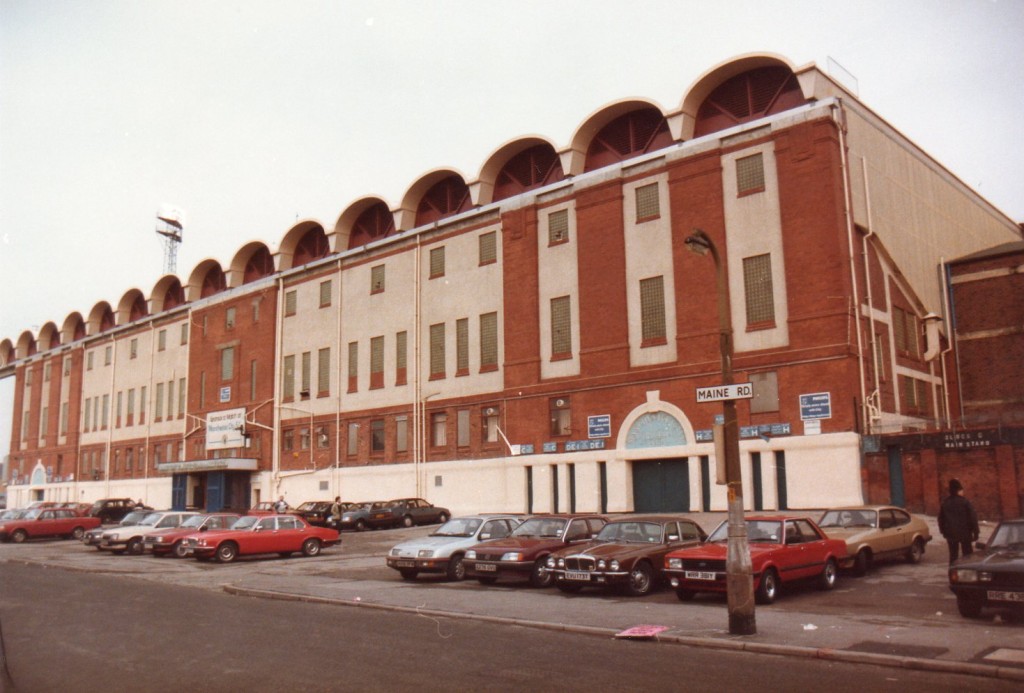
Big plans for the future
Subsequent safety adjustments slightly reduced Maine Road’s capcity from 52,200 to 49,500. Over the 1992-93 closed season, the development of the Platt Lane End commenced to finish the following March. The new Umbro Stand featured two tiers of 24 executive boxes each, a disabled persons balcony and one tier of approximately 6000 seats. The Taylor Report ensured that the Kippax Street terrace was demolished and rebuilt at the end of the 1993-94 season. The completed Kippax Stand now consisted of 3 tiers with around 11,000 seats.
At this point Maine Road appeared disjointed due to the apparent absence of any previous overall development policy. The board therefore published details of the future development of the ground where the final plan consists of a 45,000 seater stadium with a restaurant/shopping/ticket office complex situated on the former Kippax car park.
The plan was to finish the build by 1999 and have a modern stadium with total capacity around 45,024 seats. The work started in May -94, when Kippax was torn down. The following season approxomatly 5000 seats were available on the old stand. When the work was completed; Maine Road was more streamlined than ever, with 2 floors of seats around the field. Between the floors there were plans for 246 executive-boxes (or VIP-boxes). The administration moved out of Maine Road, and the old office section turned into a fashionable restaurant. Plans existed for a shopping street, pubs, more restaurants and even a museum. Total cost was estimated at £40,000,000.
Before the rebuild started, the ground capacity was 39,539. When Kippax was torn down there were 21,096 left. This was increased when 5,000 seats was placed upon the old Kippax. In February 1995 the rest of the seats was added, giving a ground-total of 31,238. When the Kippax roof was finished, so was phase 1A. Phase 1B and 1C gave 576 more seats in 72 VIP-boxes on Kippax. The other 400 goes on the Umbro Stand. The biggest difference was still the building of a restaurant in Main Stands 1st floor. Total capacity after phase 1 was 32,214. In the next phase Kippax was finished off with a centre at the back of the stand, including shops, offices and a community centre. Between the Kippax and Umbro stands, a corner for away fans were raised, with 1,600 seats and 13 VIP-boxes. Total capacity for the corner were 1,704.
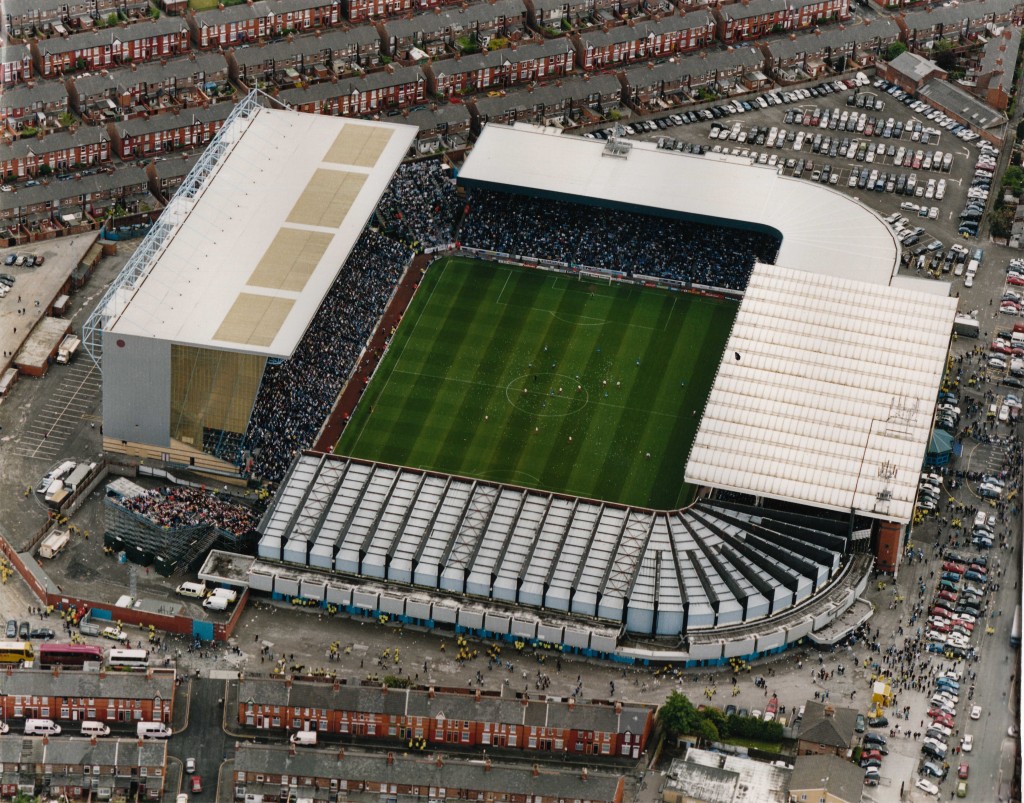
Also the corner between Kippax and North Stand needed improvement. 3,400 ordinary seats, and 264 seats in 33 VIP-boxes were planned. Total ground capacity after phase 2 was 33,918. The rest of the plan was never executed, partially due to the fact that City dropped down two divisions and had were fighting bankruptcy, and a more lucrative deal came along.
The end and the move to Eastlands
The new “City of Manchester stadium” in “Eastlands” had originally been built to host the 2002 Commonwealth Games in Manchester. It had been decided that on conclusion, Manchester City Football Club would inherit the stadium as their new home ground to replace the old (but much loved) Maine Road stadium in Moss Side. After the Games the Stadium was further developed, a new North Stand was installed and the running track was removed and re-laid at other sporting venues. Many fine new facilities were also added, including six restaurants and purpose-built function rooms which provide bookable on-site hospitality on both match days and non-match days. There are also over 2000 car parking spaces on site, (a vast improvement over the old street parking at Maine Road), and a further 8,000 accredited car parking spaces in easy reach of the Stadium. The Stadium can also be easily reached by rail and bus, being just a 20 minute walk from Manchester Piccadilly Station and the city centre.
A capacity crowd of 35,000 fans watched the final game at Maine Road on Sunday 11 May 2003. Hundreds more who couldn’t get a ticket wandered outside, full of memories, saying their own farewell to the stadium. Typically, City lost. But their long-suffering fans sang ‘Blue Moon’ long after the final whistle and it was an emotional day. After 80 years at Maine Road, City move to the City of Manchester stadium at Eastlands in September – which was built for the Commonwealth Games.

Manchester City moved into their new 48,000 seat stadium at the start of 2003-2004 season. Marc Vivien Foe had been the last Manchester City player to score at Maine Road, and two months later he collapsed and died on the pitch while playing for Cameroon in the Confederations Cup in France. Maine Road become the focal point as fans came to pay tribute and mourn his tragic death.
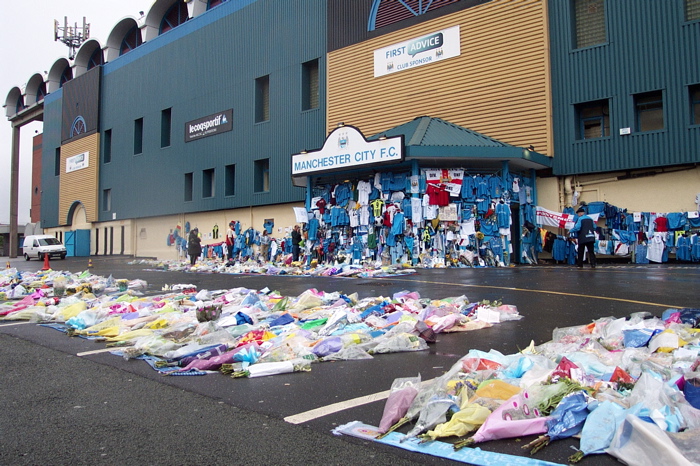
On the site now stands 474 new homes. There is a public art display commemorating the stadium and features a circular plate half open, symbolising the centre spot and the new emerging development which now sits on the Maine Road stadium.
